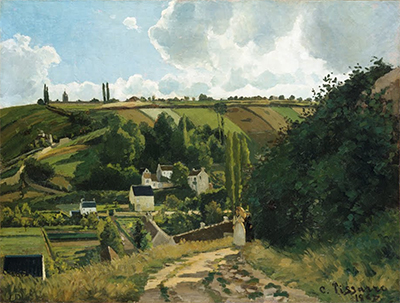Jalais Hill, Pontoise was Pissarro's most popular painting. It is known to have cemented his skill in landscape painting. He painted it in 1867, but it was only showcased at the Salon in 1868. Camille and his family had moved to Pontoise during that year before settling in Louveciennes.
The painting illustrates a French rural landscape of Pissarro's intermittent home in the northwest region of Paris. Viewers are led to a curved path where two women emerge around a bend. The background showcases Pissaro's village dotted with a few houses and vast plantations. Emile Zola, a cultural critic and French author, lauded this particular piece and said that it was an excellent example of modern landscape painting that depicted strength and life. The author went on to describe the way Pissarro handled the subject matter. He explained that the picture was an authentic representation of the modern countryside. The inclusion of the little valley showcased the painter’s simplicity and forthrightness.
Initially, Camille followed the standards enforced at the Paris Salon as it was the official body that dictated the type of art that was acceptable. At the time, the Salon was the only place artists could showcase their work in a bid to gain exposure. Later, Pissarro's paintings borrowed greatly from Camille Corot, who mentored him. Both artists had a liking for rural scenes painted from nature and Pissarro began painting the outdoors using the technique plein air. His interaction with Corot helped him understand the importance of painting nature in its purity. As a result, Pissarro started to leave the city to paint the countryside in a bid to capture the reality of village life.
Camille was fascinated by the French countryside and found it worthy of painting. He would work on the sky, ground and vegetation at the same time and rework it continually until he had achieved the best view. However, Corot, his mentor, completed his beautiful paintings in a studio where he would revise the art to his preconceptions. Camille was indifferent to this technique as he preferred finishing his paintings in the outdoors to achieve a realistic feel. This is because he emphasised the importance of grasping and painting the first impression. He painted what he saw- mounds of earth, trees, plantation and rutted bushes.
Corot had a significant influence on Pissarro's paintings. It was from him that Pissarro developed a sense of naturalism and his passion for outdoor art. Later, Camille developed a liking for the tranquil landscapes that were created by Charles-Francios Daubigny and Gustave's down-to-earth realism. During his stay in Paris, Camille met other young painters, including Paul Cezanne, Claude Monet and Armand Guillaumin who are credited with pioneering the Impressionism painting technique. Pissarro never stopped borrowing from the work of other painters. A careful examination of his work shows he got ideas from Cezanne, Monet, JMW Turner, a few Barbizon painters, Georges Seurat, Renoir and Johan Barthold Jongkind.




